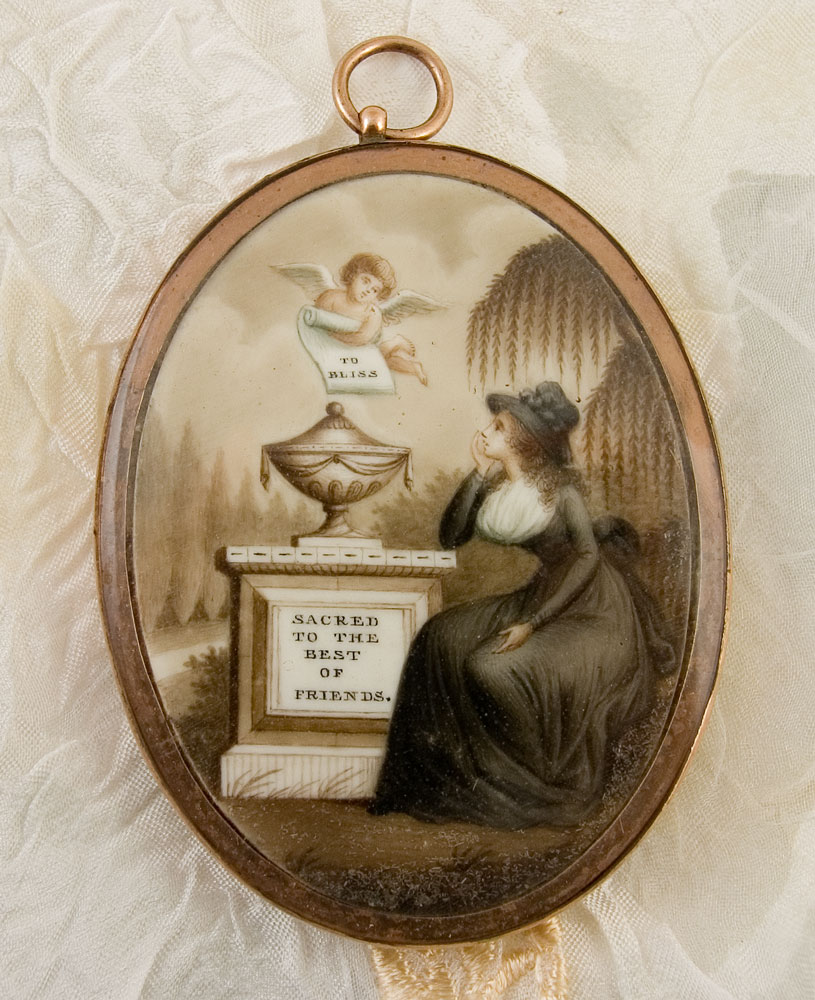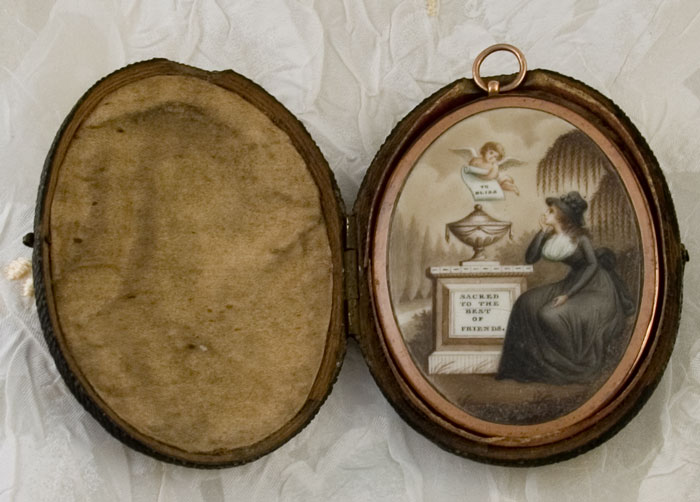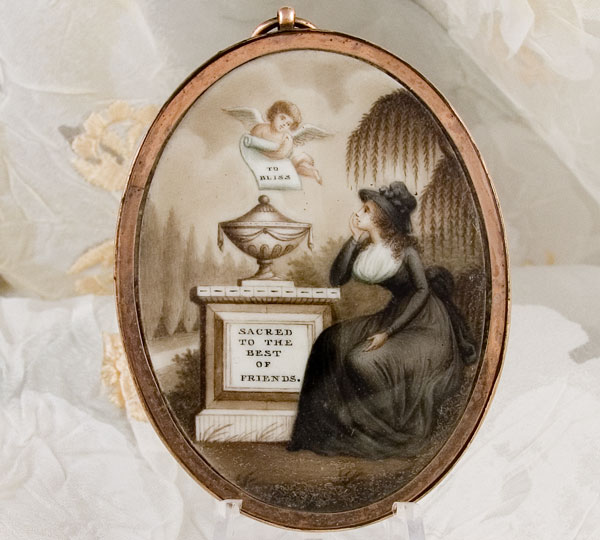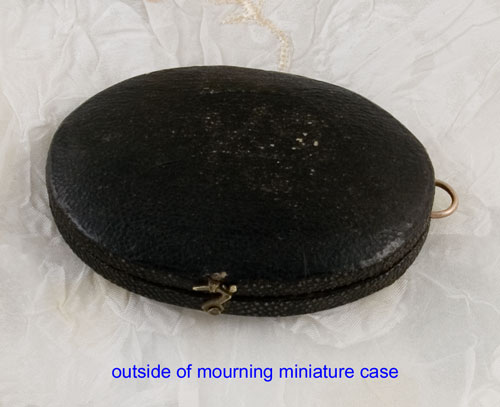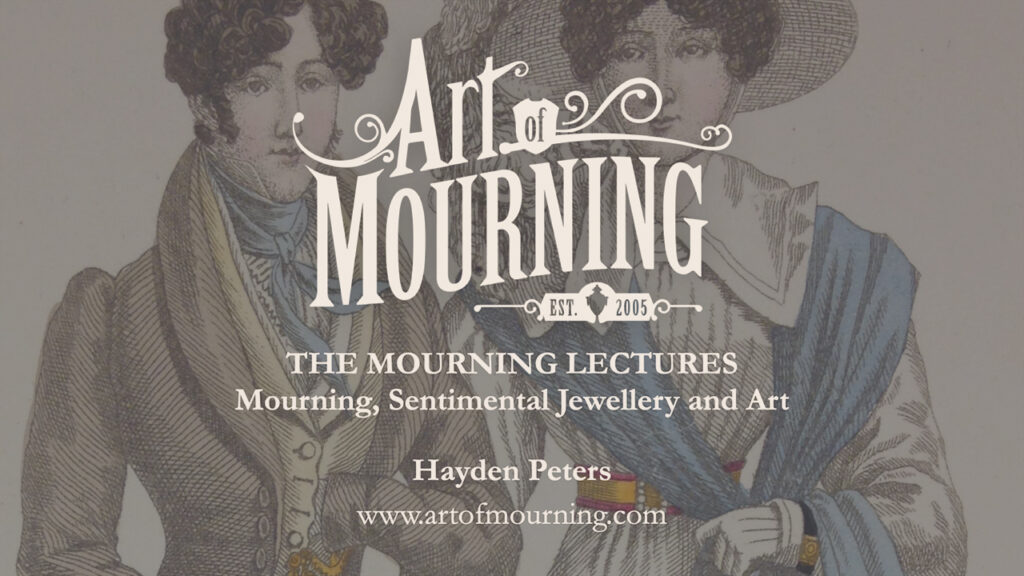Property of a Lady: 18th Century Costume, Mourning and Art in a Neoclassical Miniature
Let me begin today’s lesson by stating that to some degree, mourning jewels are fundamentally sentimental and quite personal. There is little to no doubt about that. Grief isn’t something that can be measured by price, it’s not an affectation and it’s not something that any layer of pomp can prove justification to.
When it comes to jewels, no matter what the quality, they were worn for the ideal of grief, regardless of their quality and when you see a piece that not only defies the mainstream, or tradition, of popular at a certain period, you know you’re looking at something special. Does that make the piece any more sentimental than any other mass produced item from a catalogue? I think not.
This piece rises above the expectations of the time in which is was made, it produces a bold statement about the person who held/wore/commissioned it and it demands an immediacy of emotion that was rarely captured in miniature paintings, an immediacy and proximity to the subject that perhaps only photographs could manage to take.
Why is this so? Well, let’s start with the facts. This piece is pained on ivory, measured 1.75 (4.3cm) by 2.25 (6.8cm) inches (loop excluded), set in rose gold. We have a young woman looking up to the cherub carrying the scroll with the writing ‘TO BLISS’, behind her is the willow (grief) and to the distance are the cypress trees pointing their way towards the heavens. In front, we have urn resting on a plinth with ‘SACRED TO THE BEST OF FRIENDS’. All this is painted in hushed sepia tones, except for the cherub and female. On the reverse, we have tightly woven hairwork.
Let’s begin with the lady herself. She is has completely defied the mainstream paradigm of the Neoclassical ideal with depicting herself directly into the miniature itself. Now, obviously miniature portraits captured the depiction of the subject and there are jewels which show the individual painted into the scene, but we’re dealing with a quite standard mourning depiction where the woman was considered the essence and centre of grieving. Yet, this piece shows the young lady with her eyes gently upturned and her chin resting upon her right arm, without the outpouring of sadness, but with a look of reassurance in the afterlife. If this piece was given or used for personal sentiments, then it’s just created immediacy of sentiment through this portrait. The woman is physical, she, as in a photograph, is captured in a moment in time forever mourning for the child.
Then there is her costume to consider. I put a lot of importance in this piece, mostly due to how naturally it captures the costume. Notice the folds of the dress and the creases; this is using the Neoclassical costume as a basis, but with modern mourning attire (for the late 18th century) painted on top. Note what the mourning standard for female attire was c.1765 from Ordre Chronologique des Deuils de la Cour:
“‘dress was cut with a train and turned back with a braid attached to the side of the skirt, which was pulled through the pockets.’ This is where the overskirt is turned to the back and lifted up, revealing the petticoat underneath, called; robe retrousee dans les poche, the centre front robings were joined with hooks or ribbons. Cuffs were cut with one fold and deep hems, the waist was held in place by a crape belt that was tied on. This left two ends hanging down to the hem of the skirt. A woman’s accessories were a crape shawl, gloves, shoes with metallic bronzed buckles, a black woollen muff and a black crape fan. Head dresses of black crape and white batiste were referenced. For much of the century, however, ‘paniers’ were fashionable, but in the French style, with loose pleating falling from the shoulders to the back. The English manner of this was with the back pleats stitched down as far as the waistline. Also popular were lace ruffles at the neck and the cuff, embroidered stomachers, silver gilt lace, appliqué work and small aprons. None of these were permitted for mourning wear. Mourning wear for women still remained consistent in that it remained plain, black or sometimes white fabric”
Then look back to our lady and see how she has represented mourning fashion for the time. She is quite a fashionable lady and she adheres to the standard of high fashion quite well. From her bonnet to her black crepe belt, it seems the miniaturist captured her in a very literal garment.
From this, we can look at the symbolism itself, in which doesn’t defy typical mourning style for the Neoclassical period, but it does present these symbols in superb detail. Compare this piece with another excellent example from the late 18th century. Despite the use of colour, the symbolism is in the similar style, there’s nothing here, apart from the lady, to suggest this piece was trying to invent a new style or put a spin upon the established ideals. But look at the quality of the urn, look at the delicate shading underneath and the fine brush-work to the edges. Even where the urn is draped, though it is in sepia tones, the understanding of dimension is there. The depth of this piece cannot be understated and the plinth shows this perfectly. Here, the third dimension of the plinth and the very stones that construct it are almost physical to the touch. You can even note the use of materials, you can see that there is ivory panelling contrasting with the stone underneath. Each panel is superbly lined up and given level and dimension, just through superior art and shading.
From the look of the angel, his colour breaks the colourless visage of the depiction and shows that there is life from the heavens, his colour is breaking free from the mortal world into the bright heavens. Note the hairstyle and how that would have reflected the style of contemporary children as it would seem the artist had a model to base this on, rather than the straight interpretation of a pre-established Neoclassical face (referenced from antique art).
As to how and why this piece was worn or commissioned, now there is quite a lot of opinion about why this is so. There are two things about it which I think are most interesting. One is that the mourning lady isn’t overtaken with grief upon her face and the other is the sentiment ‘SACRED TO THE BEST OF FRIENDS’. One school of thought about this is that this may have been commissioned by an affluent and fashionable lady for a friend/relative, but other interpretations I’ll let you discuss, because after all, how are we to be absolutely sure?
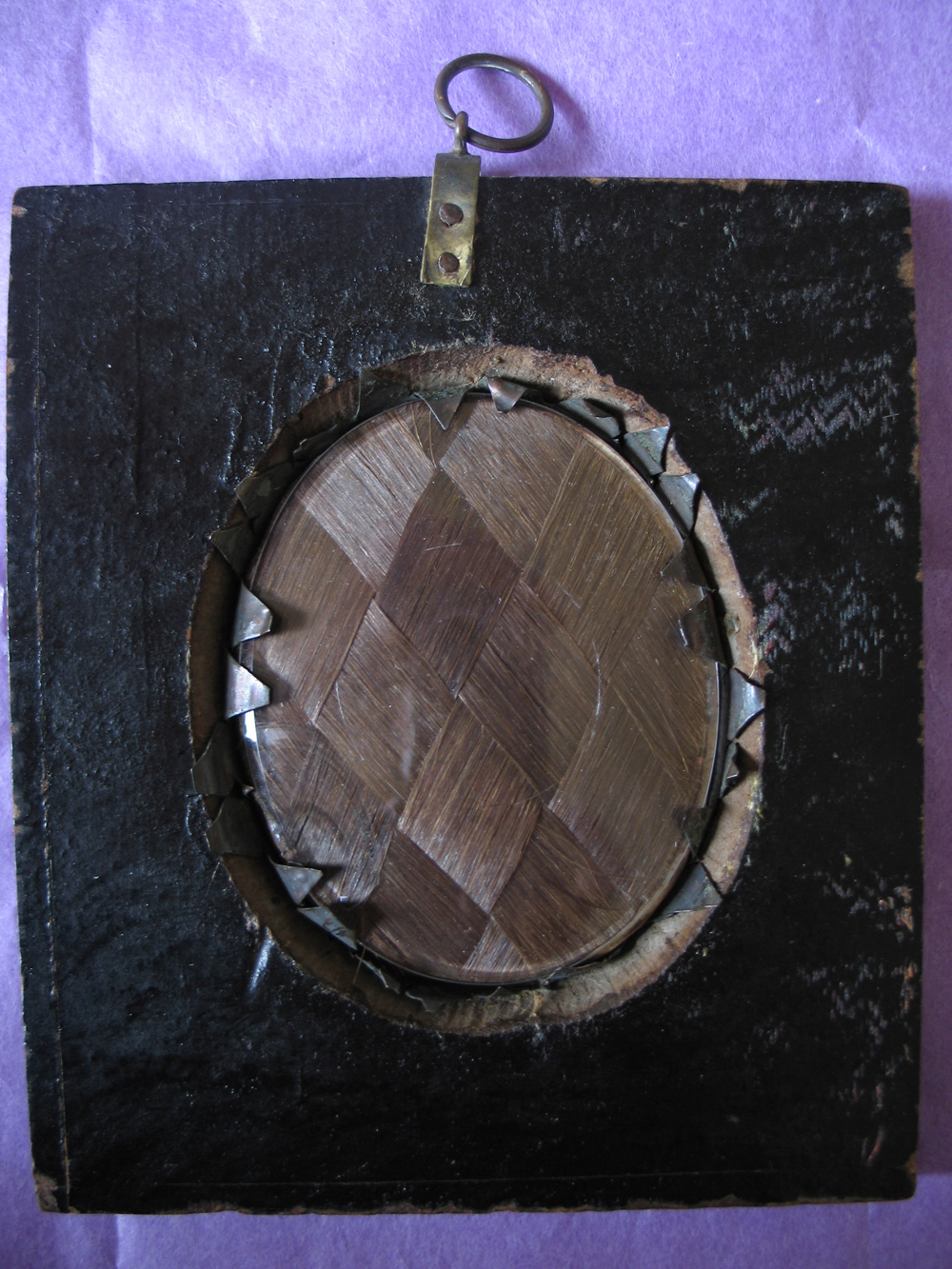
On the reverse, we have this rather tight hairwork weave. This style is common with many contemporary American and French sentimental and mourning jewels, obviously the style has carried into this. With this piece also comes its original travelling case, which makes it even more rare, special and sentimental.
Overall we have a rather remarkable piece that fills me with joy that it even still exists. Why pieces like this aren’t as precious as any other art form is beyond me, but the very fact that I can present it here for you to study is enough.




